Hazel Dormouse appeal

Help us protect its hedgerow habitat
PLUS:
Jumping spiders
Generational amnesia
Look East or Go West?
ISSUE 185 | SPRING 2023
Trust
Surrey Wildlife
Ecology Services
From macro photography to wildflower ID, get closer to nature this spring
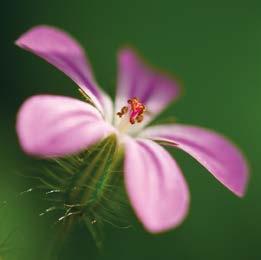
Find out more at surreywildlifetrust.org/courses


Robust and pragmatic ecological and land management advice for landowners and developments of all sizes
Find out more at swtecologyservices.org
Tom Marshall
Surrey Wildlife Trust
Ben Hall/2020VISION
Surrey Wildlife Trust
Surrey Wildlife Trust’s membership magazine, published three times a year. Surrey Wildlife Trust, School Lane, Pirbright, Woking, Surrey GU24 0JN.
T. 01483 795440 E. info@surreywt.org.uk
Editorial enquiries and contributions should be sent to the editor: Oliver Fry
T: 01483 795440
E: oliver.fry@surreywt.org.uk
© Surrey Wildlife Trust 2023
DESIGN
The Way Design
E: hello@thewaydesign.co.uk
W: thewaydesign.co.uk
WRITER
Simon Prichard
E: simon@zurito.co.uk
ADVERTISEMENT ENQUIRIES:
Sadie Miller
E: sadie.miller@surreywildlifetrust.org.uk
MEMBERSHIP
New memberships, gift memberships, change of address, change of bank details, cancellations and amendments should be sent to the Membership Department at the address above, or telephone the Membership helpline: T. 01483 795445
E: membership@surreywt.org.uk
CHARITY
Patron: Dame Judi Dench
Chair: Angela Swarbrick
Chief Executive: Sarah Jane Chimbwandira

Director of Finance: Sarah Glasspool
Director of HR, Culture & Support Services:

Catherine Roberts
Director of People Engagement: Aimee Clarke
Director of Reserves Management: James Herd
Director of Research & Monitoring: Mike Waite
Surrey Wildlife Trust is a member of the Wildlife Trusts Partnership.
Registered Charity No 208123
Registered Company No 645176
VAT No 791 3799 78
Cover image: Hazel Dormouse
© Terry Whittaker/2020 vision
All images © SWT unless stated
FIND OUT MORE ABOUT OUR WORK:
Like us on Facebook
Follow us on Twitter
Find us on Instagram surreywildlifetrust.org
A winning combination
As we were gathering the articles for this issue of Surrey Nature I was struck by how often they depicted a beautiful contrast between the old and the new – and how both have a vital role to play in our work.
As you know, we are excited to be partnering with the University of Surrey, Buglife and the Painshill Park Trust on the Space4Nature project, which combines high-resolution satellite imagery, AI software and ground-level observation by real people in muddy boots. This apparently unlikely mix will in fact enable us to accurately map different habitats across the county and help us connect complementary areas of land for the benefit of wildlife.
A similar story emerges when you consider our spring appeal, which aims to raise funds to establish, restore and manage important hedgerow and woodland habitats that support Dormice and many other species of animals, plants and fungi. The money we generate will pay for a wide range of work on the ground, including volunteer surveys conducted on smartphones using specialist software, and traditional hedgelaying and coppicing carried out by experienced experts and newly trained recruits.
As well as a vivid juxtaposition of the latest technology and ancient practice, both of these examples personify a growing role for the Trust, in that they require us to act as a catalyst
for wider change. It seems to me that conservation as a whole is evolving from a mainly protective endeavour, in which we focused inwards on our own patch, into a collaborative movement that involves mutual support, the transfer of knowledge and skills, and a willingness to share. Echoing this theme, our interviews with six women who work for SWT (starting on page 14) reveal an interesting shift over the last twenty years, both in the career opportunities available to women and broader attitudes towards diversity and openness.
It is in this spirit that I wish you the very best for 2023 and encourage you to get involved with the Trust’s work. However negative the media headlines about the climate and biodiversity crises, we are working harder than ever to make a positive difference for nature here in Surrey. The more we reach out, the more we realise we are not alone – and our collective voice is growing louder. With your help, we achieve real change and help create a healthier future for wildlife and people.
Thank you.
© Jon Hawkins
Sarah Jane Chimbwandira Chief Executive
"Our collective voice is growing louder."
SPRING WELCOME 3
Innovation, diversity and tradition create a recipe for success
IN THIS ISSUE...
Want to have your image featured as our next ‘Photo of the season’? Share your best photos of summer with us. Email them to: oliver.fry@surreywt.org.uk or
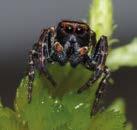
@surreywt #surreynature
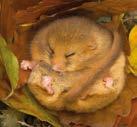


18 DORMOUSE APPEAL 10 JUMPING SPIDERS FEATURES 12 Recognising nature's value New approaches to conservation 14 Agents of change Women leading the way in conservation 23 Online shop Our new online ethical clothes shop 24 Spring species: Skylark 26 Talking trees REGULARS 3 Sarah Jane Chimbwandira 6 News 28 Corporate news 29 SWT in the community Bees, beans and butterflies NATIONAL 30 UK news 32 Leading by example 34 Wildlife gardening on a budget
GENERATIONAL AMNESIA 8
share
social media:
GIVE US YOUR BEST SHOT
them on
Photo © Jon Hawkins, Surrey Hills Photography
© Mike Waite © Danny Green
SPRING CONTENTS 4
© David Longshaw
CUCKOO
The average lifespan for a Cuckoo is between 4 and 9 years, so at around 11 years, Colin (a regular at Parish Field, Thursley for almost a decade) is possibly the oldest of his kind on record.
Will he be back again this year? Start listening out for Cuckoos in woods and grassland from April.

5
SPRING PHOTO OF THE SEASON
OUR NEWS

Mary’s legacy
The family of former SWT member and Bramley resident Mary Rae has made an in memoriam donation of £12,000 to the Trust in her name. Mary died in 2022, having been an SWT member for 55 years.
Mary was an active supporter of nature conservation, allowing her large, previously formal garden to run almost wild for the benefit of Badgers, Foxes and deer. In spring she joined Toad patrols, helping amphibians to cross roads safely to their breeding ponds. Mary travelled widely and was a keen nature photographer.
This kind donation will enable us to continue to support her beloved wildlife. All our reserves are long-term projects, requiring sustained investment and management over many years – and a gift in your Will is the perfect way to secure their future.

If you’d like more information about the impact that such a gift can have, and the work it can support, please visit surreywildlifetrust.org/legacies
Pioneer reserves
SWT sites at Chobham Common and Quarry Hangers, along with Painshill Park, have been chosen to test Space4Nature’s new combination of satellite Earth observation, artificial intelligence (AI) and citizen science. As reported in previous issues of Surrey Nature, this trailblazing initiative to map, connect and restore habitats across Surrey is part of a three-year Space4Nature (S4N) partnership between SWT, the University of Surrey, Buglife and the Painshill Park Trust. It has received £1.25 million of funding from the People’s Postcode Lottery Dream Fund.
The S4N team will use high-resolution satellite imagery of Chobham Common to analyse and map its diverse terrain. Ground level survey information gathered by ecologists and trained local volunteers will first serve to interpret the imagery, that will then teach AI software to accurately

predict similar pockets of habitat across the site. This will enable the team to recognise and pinpoint which areas of land should be joined up to other habitats of a similar type. Meanwhile at Quarry Hangers near Caterham, S4N is carrying out test mapping and restoration work. Buglife will also clear scrub in order to strengthen its nationwide network of insect superhighways or ‘B-Lines’, which help pollinating insects move around and feed safely across the UK.
Another key site will be project partner Painshill Park in Cobham, an 18th Century landscape garden designed as a ‘living canvas’ by Charles Hamilton and boasting a large lake, woodland, arboreta, a vineyard and grassland. This range of environments will be ideal for testing and refining the satellite imagery and AI. And through Space4Nature, schoolchildren who visit as part of Painshill’s programme

Painshill Park
of curriculum-based outdoor learning activities will learn how to record species and investigate nature as they examine the park’s plants and animals and their habitats.
As part of the habitat-mapping process, Painshill Park will also host a major ‘BioBlitz’ event this June, which will be open to the public as well as specialist recorder groups. We’ll provide updates on this, and how you can take part, at surreywildlifetrust.org
SPRING NEWS 6
A NEW VOICE FOR YOUNGER PEOPLE
Our mission to involve more young people in conservation and the work of the Trust, and build a cross-county Wild Youth movement, has gathered pace with the creation of a new Youth Action Committee.
Comprising Surrey residents aged from 16 to 30, the Committee will:
Give us advice on how to inform more young people about the natural word and use their insights to help tackle the issues nature is facing.
Develop social media content and events to ensure more young people get involved in our campaigns and activities.
Nature Discovery Days to get underway at Nower Wood


To complement our tutor-led programme for school children at Nower Wood nature reserve, SWT has now launched a volunteer-led programme for schools.

This will enable the Trust to connect more children with the natural world and provide an affordable option for schools struggling to fund school trips in these challenging times.
Volunteers have been trained by our professional tutors to deliver the sessions, are DBS checked and first aid trained. The programme introduces children to pond life, woodland invertebrates, trees and habitats through a range of hands-onactivities. If you are interested in booking your school, please do not hesitate to contact the education centre by phoning 01372 379509 or emailing education.centres@ surreywt.org.uk
We are always keen to train up new volunteers to help us with our outdoor learning programme,
and the new scheme is a great way to share your knowledge of nature. Volunteers can work on any aspects that suit them – whether that’s leading walks or just providing an extra pair of helping hands – so please do visit the schools section of our website to find out more.
Our team is also continuing to deliver the Wilder Schools programme, where we work on site with students to improve their school grounds for nature and help teachers to take learning outside. If you know of a school interested in joining this free programme, applications for September 2023 are open now.
Contact the education centre or search for ‘wilder schools’ on our website for more information.
Help us produce a newsletter for young people, expand our youth network and raise the profile of our work across Surrey.
Team Wilder Engagement Officer Laura Ashfield comments:
“We hugely value the support and participation of all our members, but we won’t be able to deliver the longterm change we need without the active involvement of younger people. This new group will ensure that we grow our movement, remain relevant to everyone, and persuade more people to live in a way that supports rather than degrades our environment.”
The committee was created following a consultation with our younger members during 2022. It will meet regularly throughout the year with the first online meeting taking place in March, and its recommendations will be delivered to our senior management team. Stay tuned for further updates in this magazine and online.
Keeping the flame alight: we need more young people to get involved.
Pupils from St Marks and All Saints school pond dipping with volunteer Viv Sidlin
Right: Minibeast hunting with staff member Emma Rothwell.
SPRING NEWS 7
© Jon Hawkins, Surrey Hills Photography
Is generational amnesia driving acceptance of nature’s decline?
Ben Siggery is GIS, research and monitoring manager at SWT. As part of the Space4Nature project, he is researching a Doctoral thesis that looks at how measuring past evidence can help us set targets for future biodiversity.

As conservationists go about restoring habitats and nature, how do we decide what a healthily populated natural environment should look like? We can compare past trends to the current state of the natural world, but where is our baseline? When setting targets to measure our success in helping nature’s recovery, do we go back to the 1960s, the 1860s, or the 1460s?
Shifting baseline
The term ‘shifting baseline’, often used in reference to climate change, suggests that because the environment has changed so drastically, the level we can realistically reattain is far away from what we ideally want.
A similar phrase, ‘shifting baseline syndrome’, refers to the related change in perception of what we consider
normal – in our case, what we think a healthy ecosystem should look like. This term was originally coined in 1995 by a fisheries scientist called David Pauly, who observed how successive generations of fisheries staff had different reference points for fish populations and how depleted (or not)
they ought to be. Because the scientists’ expectations were largely based on the state of the fishery at the start of their careers, and because global fish populations continue to decline, each new generation accepted progressively lower standards as ‘normal’.

8 SPRING MONITORING
Science or reminiscence?
This phenomenon has been described as generational amnesia – a fascinating term. We have all heard stories (or perhaps even have personal memories) of how there used to be so many more birds in our gardens, more greenery in the countryside and more wildlife all around us. Recently, longstanding SWT member Michael Lidstone kindly shared his personal wildlife diaries with us. His detailed observations from April 1984 to December 1990 note a vastly greater diversity and abundance of wildlife, including Common Toads, Hedgehogs, Greenfinches, Bullfinches and Lapwings, than we might expect today. Records like Michael’s are hugely informative reminders that we should not continue to tolerate the steady depletion of biodiversity in our gardens, parks and reserves.
Splatometer
Another reference point is the number of insects splatted on our car windscreens. Kent Wildlife Trust and Buglife have run a ‘Splatometer’ study since 2004 and have recorded a 59% national decrease in ‘splats’. While some readers will surely remember driving with heavily splatted windscreens, I only started driving in 2010 and have never really experienced this. My reference point is likely to be massively different from both my parents’ and that of future drivers. So, what does this mean for nature’s recovery?
Read more of Ben Siggery’s blogs and the latest news from Space4Nature at surreywildlifetrust.org. uk/space4nature
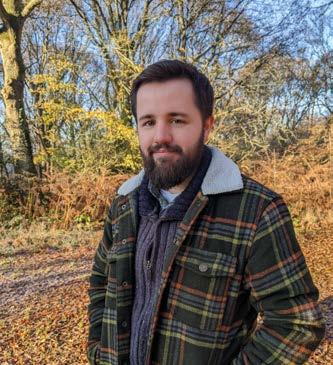
If you tolerate this...
Research has shown that shifting baseline syndrome among the public is unfortunately likely to lead to increased tolerance for a degraded environment, as well as a generally lowered environmental awareness. There are also concerns about what this may mean for official nature recovery targets. For example, attempting to maintain or only slightly enhance current levels of bio-abundance would still mean accepting numbers of insects, birds and mammals that would seem shockingly low to our grandparents. Current UK policymakers’ lack of ambition on this front, from weak targets for the restoration of nature to slow action on climate change, is well-documented.
Sign of promise
Researchers have recently looked at this phenomenon with more empirical methods. One good piece of news is that a 2021 study* found that although the general public perceptions are clearly affected – reliant as they are on memories alone, there was no significant impact on conservation professionals and researchers who must dig deeper. More work is needed and we mustn’t forget that public opinion rather than science tends to drive political action, but this is a promising sign that shifting baseline syndrome might be an undercurrent rather than a significant influence on how conservationists set restoration targets. ■
If you have a wildlife diary that you’d be prepared to share with the Trust, we’d love to see it. Please contact oliver.fry@surreywt.org.uk
Journal of Environmental Management,
297, 113308,
* Is there evidence of shifting baseline syndrome in environmental managers? An assessment using perceptions of bird population targets in UK nature reserves. / Jones, Lizzie; Turvey, Samuel T; Papworth, Sarah. In:
Vol.
01.11.2021.
9 SPRING MONITORING
Kent Wildlife Trust and Buglife have run a ‘Splatometer’ study since 2004.
Jump They Say…
There’s much to admire about the family of diminutive dancers known as jumping spiders.
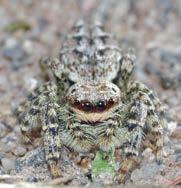
 Mike Waite, SWT Director of research and monitoring
Mike Waite, SWT Director of research and monitoring
Meet the Fence-post Jumper SPRING SPECIES FOCUS
Many-coloured Jumper
The Salticidae or “jumpers” are an endearing family of small to tiny spiders that I defy the most ardent arachnophobe to not at least admire, if not fully fall in love with. I have seen them described as ‘cute’ and even ‘cuddly’. But how ever one view’s them, they are certainly a fascinating group to study. The family name Salticid derives from the Latin for a gymnast or dancer, which is an excellent moniker in my book.
Their specialism is clearly in abrupt but extremely accurate mobility –also serving their predatory strategy. Apparently similar behaviour is seen in many small invertebrates but is usually an adaptation for escaping predation. Witness the click and flea beetles, and of course the primitive springtails. Most have evolved an extra tensile appendage that, when triggered, can flip the whole creature out of harm’s way. Not so in jumping spiders however, whose stout little legs are suddenly straightened under internal hydraulic pressure to provide the necessary explosive propulsion. It is interesting to watch the spider preparing for a leap; it will carefully
line itself up on the receiving surface or prey item, stretch out its front pair of legs as if to gauge the distance involved, squat to attach its silken safety line and then – off!
Concerning spiders, I have written before that Surrey is an arachnologists’ paradise, with a list representing some 62% of the British species diversity. This includes 21 jumping spiders, including several for which we hold important populations. One is the Metallic or Gorilla Jumper Evarcha arcuata, as a species of damper heathlands and fen margins. The male resembles a miniature ‘silverback’ –black overall, with a paler abdomen, massive forearms and even a tawny crown. This has a nationally restricted distribution but is quite easy to find on sites like Whitmoor and Chobham Commons, Boldermere and Barossa. It has a near relative, the Many-coloured Jumper Evarcha falcata, which is found in a wider range of habitats but at apparently lower densities. Another relatively large species is the Fencepost Jumper Marpissa muscosa


Again range-restricted to the southeast, it is fairly common though in
Surrey and may be found basking in sunshine on older wooden picketfences and gates. Like several other jumpers this species’ facial detail is quite exquisite, with a mask of scarlet hairs through the eye-area.
Jumping spiders’ eyesight is exceptionally well-developed, with the larger front four providing strong binocular function and the two smaller lateral pairs together affording near allround vision. As one bends closer to examine a jumper it will very purposely jink around to give you a good lookover for the sake of risk-assessment.

The most commonly met jumping spider is perhaps the Common Zebra-spider Salticus scenicus found on garden furniture, sheds and sometimes inside houses. Its pied appearance is characteristic although there is another related species found in wilder habitats and with less clearcut stripes – the Belted Zebra Salticus cingulatus. Males of this genus have elongated jaws (chelicerae), which are clearly noticeable. Some of our species are truly tiny, often only a few millimetres long. One is the Sedge Jumper Callositticus caricis a Sphagnum-bog specialist that is present at Gracious Pond and at the Folly on Brentmoor Heath. Another is the White-palped Jumper Euophrys frontalis, a true dwarf, with males exhibiting a physical character fairly typical in certain jumpers, where their first pair of legs are longer, thickened, contrastingly coloured, or a combination of all three. This is indicative of these species’ elaborate courtship behaviour, with males engaged in semaphoric waving of their modified front limbs when facing a female. In some tropical species both the modifications and their use are nothing short of spectacular.
Interestingly it is a very rare jumping spider that recently scuppered plans to build a Disneyland-scale theme park on the southern bank of the Thames in Kent. The Distinguished Jumper is only found on the proposal site and its opposing bank in Essex and hence provided the special interest necessary for designation of a new Site of Special Scientific Interest (SSSI) – game over for London Resort plc..! ■
11
youtube.com/watch? v=HPh_Gi7PCqs)
See
Gorilla Jumper
Common Zebra-spider with prey Sedge Jumper
Images © Mike Waite
SPRING SPECIES FOCUS
In
Recognising nature's value
Sarah Jane Chimbwandira, CEO Surrey Wildlife Trust
Instead of assuming that the needs of the economy and wildlife will always be at odds, the time has come for a more intelligent economics that recognises and respects the value of natural capital. This increasingly familiar phrase describes the world’s stock of natural resources, such as soils, water and living organisms. It’s obvious that these assets underpin all economic activity on Earth, as well as the wellbeing of every human being. It’s also clear that, over recent centuries, the demands we have made on natural capital have been unsustainable and now threaten the entire global economy.
Working with nature
We often recognise the instrinsic value of nature, but to increase the visibility of nature in decision making we need to look at – and place a cost value on – the services it provides. For example, a revitalised wetland area can create a valuable carbon store and flood defence; a new city park can help cool a neighbourhood and improve peoples’ health – and both deliver a measurable economic as well as social benefit.
For more than ten years, SWT has explored the potential of naturebased solutions (NBS) and we have now embraced it in our programme of practical work. Our first major NBS project was funded by Coast to Capital
(C2C), a local enterprise partnership whose pioneering new investment model places nature’s recovery at the heart of the local economy. In 2020 C2C funded us to deliver a nature recovery network between Redhill and Godstone and create a system of green corridors to help wildlife move and thrive.
This work included a huge 400-tonne sand installation at Spynes Mere nature reserve, providing hundreds of new homes for Sand Martins whose traditional nesting sites are temporally insecure and thus under threat.
Above: Wildflower meadows store carbon, support pollinators and enrich lives. © Lee
 Schofield
Schofield
New approaches to conservation can deliver both economic growth and flourishing biodiversity
Personal view
this new series SWT staff and stakeholders will offer a personal insight into a wildlife-related topic.
12 SPRING PERSONAL VIEW
Green growth
We are also undertaking two major projects as part of the government’s Natural Environment Investment Readiness Fund (NEIRF). We’ve successfully bid for £100,000 to establish a natural capital investment company to model biodiversity net gain at scale in support of more sustainable development in the south of England.
We have also secured a further £100,000 to develop landowner-led natural capital investment plans for nature conservation. This involves conducting six pilot projects with large land managers in Surrey, including farmers, country estates and golf clubs, to develop natural capital investment projects.
As the world struggles with unprecedented economic and environmental challenges, I think that businesses and governments need to start putting nature’s value at the heart of every big decision. Here in Surrey, we are helping to point the way ahead.
Natural capital credits
SWT has also been designated a natural capital initiative (NCI) company, which means we can sell natural capital credits to other organisations engaging in development activity. This means that when such an organisation can’t do enough on-site mitigation to achieve biodiversity net gain, they can pay us to improve suitable nearby sites for wildlife. We have already used this mechanism to fund £900,000 worth of habitat enhancement work in Surrey over 30 years.
These new approaches are an essential departure from the traditional conservation model of acquiring and managing protected ‘islands’ of habitat in a sea of hostile economic development. SWT directly manages 3% of Surrey’s countryside; in just over a year our new NBS team is already actively influencing the management of a further 3% by providing tools, knowledge and opportunities. This kind of partnership can be scaled up to transform the prospects of people and wildlife in our county.
So, if you’re a landowner or land manager in Surrey, we invite you to get in touch. Whatever your plan for the future, we’re here to help.
You can contact the SWT naturebased solutions team at: nbs@surreywt.org.uk ■

How do you measure natural capital?
To trade in environmental net gain – whether more biodiversity, better water quality or carbon offsetting – you must first quantify the ‘credit’. This depends on both the cost to the land manager to deliver it and the financial gain for the organisation buying it.
To measure biodiversity net gain, landowners can make use of the government’s Biodiversity Metric, developed by Natural England. For example, when they plant a hedge, create a pond or set up a field margin, the metric converts that into a number of biodiversity credits, which someone such as a housebuilder may then purchase.
Codes already exist for water quality and carbon sequestration and we expect to see these mechanisms extended to evaluate hedgerows, and arable land reverted to species-rich grassland.
© Adobe / Stel 13 SPRING PERSONAL VIEW
Nesting Sand Martins © Bob Coyle
AGENTS OF CHANGE

Women leading the way in conservation
To celebrate International Women’s Day on 8 March, we asked six colleagues to tell us about their work and what inspires them.
Laura Ashfield Team Wilder engagement officer

In the early 2000s we thought a biology degree was enough to start a career in ecology but, with no practical experience, it took me a few years to find my way in. Volunteering and working part-time for Birmingham & Black Country WT, I developed an interest in helping young people that has continued ever since.
My next job with The Conservation Volunteers was tough – I got the message that women should stick to engagement roles – but it gave me great training opportunities. Over the years my minibus licence, Forest Schools knowledge, and brushcutting and chainsaw skills have helped me add practical work to my capabilities.
At my next role with Warwickshire WT my (male) boss boosted my confidence and showed me that allies are important, whatever they look like. Then a job advert for the Surrey Greenspace project hit me like a lightning bolt. I knew it was for me.
I joined an all-women team and they were an inspiration. It was liberating not to have to meet male expectations of how we should behave and perform. General outreach work in Surrey and London made me realise that if we preach diversity of habitats and species, we also need to practice diversity of people, platforms, messages and, especially, skills and experience. Conservation must be an outward-looking, collective activity, not the preserve of a single group.
Maybe the pandemic helped, as it brought all the Wildlife Trusts together online, but things have shifted recently. There are more men in education and engagement; more women in practical conservation work. Our movement has common goals. We’re less inward looking, less focused on our own small patch. Of course we must value the people who have sustained us for many years, but also welcome newcomers with open arms. These are exciting times, but we have no time to lose.
14 SPRING CELEBRATING OUR PEOPLE
Harriet Baber
Senior ecologist

I work for SWT’s in-house ecological consultancy, helping developers and other clients with the conservation aspects of planning applications. As well as enabling them to meet their legal obligations, we try to achieve the best possible outcomes for habitats and species.
I studied zoology at Exeter University, where my classmates were probably 60% female. I didn’t know what to do afterwards, but a module on consultancy must have grabbed my attention because, after working with horses for a while, I started doing some ecological surveys, then found the full-time positions that eventually brought me here.
I work for commercial clients, but they are genuinely interested in wildlife. I really enjoy it, which is just as well because it tends to take over your life – even more so as I’m also doing a Master’s degree, with support from SWT. However, there’s a clear career path and I’ve been lucky to work for several strong, inspiring women. I don’t really see a gender or age divide in the conservation sector.
Emma Randall
Nature-based solutions officer
Until recently I worked under the SWT umbrella as a data officer with Surrey Biodiversity Information Centre (SBIC). I helped provide its enquiry service for ecological consultants, local authorities, educational establishments, and others.
I had always been interested in nature as a hobby or career and had done work experience with SWT during sixth form. It felt natural to study zoology at university, and I continued with a Master’s in wildlife management and conservation.
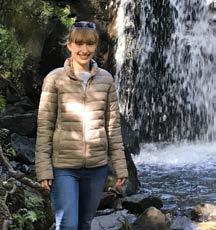
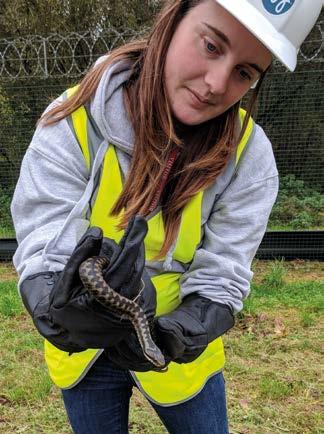
This has always seemed an interesting and important field to be involved in – and one with an even gender balance.
However, I don’t think I understood the career options at first. I certainly didn’t appreciate the vital role of environmental records centres such as SBIC.
My new job is supporting the managers in SWT’s naturebased solutions (NBS) team. I’ve been getting up to speed, learning about GIS systems, survey processes and so on. We advise landowners on how to manage land better for nature and I would encourage more of them to get in touch. It’s clearer every day that NBS is the right route for the planet – and for me. My mum’s friends are starting to talk about environmental issues, so our time really has come!
15
“I'm grateful to work alongside so many knowledgeable and inspiring women in this organisation.”
Emily Jupe Conservation manager

I’m responsible for SWT’s 17 reserves in the east of the county. This includes implementing management plans, running work programmes and meeting Countryside Stewardship agreements. It is definitely not a desk job and I’m often out on site with reserve officers, volunteers and contractors.

Of course there is some paperwork to do and relationships to manage too. I liaise with local councils, reserve visitors, neighbours and other stakeholders. I’m working hard to bolster SWT’s reputation in the community, which means being active on social media, publishing ranger notes, doing guided walks, getting involved in fundraising – and just talking to everyone. It’s all about encouraging wildlife and enabling people to enjoy our reserves.
It turned out that my zoology degree didn’t lead to training dolphins after all, despite my childhood ambitions! It was however an excellent introduction to a broad range of topics, although I had to do an unpaid internship with the RSPB to learn the ropes and get some vital training. I joined SWT in June 2021 as a reserve officer, having had experience in several conservation organisations.
“Every day is different now and I really feel I’m making a difference. Seeing a tangible impact, such as a new hedgerow on a partner landowner’s field, is so rewarding.”
16 SPRING CELEBRATING OUR PEOPLE
Right: Emily Jupe helping a hedgerow
Ashley
Greening Intern
I’m in the middle of a nine-month internship with SWT at Nower Wood. I’m part of our Team Wilder initiative, which aims to inspire people to take action for nature.

Louise Shorthose Outdoor learning manager
I have always been adventurous and outdoors-y and this combination of conservation and education really suits me. As far as I’m concerned, I can do anything – from clearing scrub to giving a talk – I just might do it differently.
I was home educated so I tended to focus on what I was most interested in, which eventually led to an online diploma in zoology. I don’t think you need to go to university if it isn’t right for you. I have also been an elite athlete in wheelchair basketball and para ice hockey.

Now I love bringing my own insight to SWT’s audiences, particularly young people, for example by doing route surveys for people with disabilities and special needs. I am encouraged by all the women in the Trust who are leading by example.
I was on track to be a bank manager when I realised that I would have to study maths and economics. It turned out that the subjects I enjoyed – geography, biology and chemistry – were much more suited to environmental science. Two degrees later, I was an environmental consultant.
I made my way to Hong Kong to advise on building and engineering projects. As a young woman with
my expertise, it was sometimes hard to be heard. Today the environment, women and youth are all taken more seriously.
I joined SWT in 2005 and I’ve been a volunteer, educator and am now outdoor learning manager. When I started, the team – and the Trust as a whole – was predominantly male, but now women outnumber men at almost every level of the organisation. ■
Above: Lou at work connecting youth to nature – in a variety of ways

“As a wheelchair user, I hope I can help other people with a physical disability to seize the opportunity to engage with nature. I’m certainly getting a lot out of it."
© Markus Dell
© Jon Hawkins, Surrey Hills Photography
17 SPRING CELEBRATING OUR PEOPLE
“Every day is an absolute pleasure and I never feel like I’m at work. It’s wonderful to see children – and adults – open up to nature. You can see a switch going on in their brain.”
HELP SAVE THE
Dormouse
One of Surrey’s most-loved but rarely-seen residents – the Hazel Dormouse – is the focus of our major new conservation and habitat creation campaign. Please help us raise the money needed to reverse the decline of this important species.

Dormice have lived in Surrey since at least the last ice age and were once common. However, populations have suffered in recent years as woodland and hedgerow habitats have suffered widespread mismanagement and loss. Nationally their numbers are estimated to have fallen by more than half since 2000.
SWT CEO Jane Chimbwandira says: “It’s easy to love Dormice, but their decline isn’t just a tragedy for people who care about cuteness – it is symptomatic of the decline of the wild places that we all depend on.
The hedgerows and woodlands that Dormice need to survive and thrive also support hundreds of other species, help protect us from flooding and soil erosion, block out traffic noise, keep the air clean and store thousands of tons of CO2. By supporting our campaign to save Dormice, you can help secure the future of Surrey as a great place to live for wildlife and people.”
Top: Careful Hazel and Chestnut coppicing benefits Dormice © TWT

Bottom: Yellowhammers will benefit from healthier hedgerows © Chris Gomersal
 © Adobe / Fabrizio Moglia
© Adobe / Fabrizio Moglia
18 SPRING FUNDRAISER
Below: Dormice have been nibbling these nuts

Healthy habitat
Our fundraising campaign aims to raise £25,000 to support the restoration and creation of hedgerows that will form connected corridors of healthy habitat across the county. We’ll also manage our woodland reserves and carry out coppicing work to enable Dormice to shelter, breed, feed and sleep safely.
Katy Fielding, project manager of SWT’s Hedgerow Heritage programme says: “Hedgerows are the forgotten heroes of Surrey’s landscape. A properly-managed example can support up to a dozen types of native trees, not to mention a huge variety of plants at the margins and base. This makes them superhighways of biodiversity, providing shelter and safe passage to countless species.
How your money can help…
£10
plants a new hazel with the guards needed to allow it to flourish into a future nesting place.
£30
delivers one metre of maintenance or restoration work on an existing hedgerow, which is vital for the long-term survival of hedgerows.
With something in fruit or in flower all year round, mature hedgerows also offer a permanently stocked buffet for bees, bats, birds, butterflies and mammals. Sadly, however, many are now in poor condition, as ancient management skills have been lost. There’s no better way to help nature recover than by backing our campaign to install and restore miles of these priceless habitats across the county.”
Hedgerow and woodland management is an ongoing project for Surrey Wildlife Trust in order to safeguard habitat survival for years to come. If you are able to support us, we would be extremely grateful.
£50
pays for coppicing work in woodland habitats to create natural nesting places for Dormice.

£2,000
enables us to manage coppice rotation of 1 hectare of woodland reserve over four years.
To donate please visit surreywildlifetrust.org/save-dormice
FACT FILE
Dormouse facts

How to recognise them
Dormice are small, weighing in at a maximum of 30 grams, and live for up to five years. They have large black eyes, golden-brown fur and long black whiskers. They are also the only small British mammal with a furry prehensile tail, which wraps around the body during lengthy winter hibernations and assists with climbing. They spend up to seven months of the year asleep in tightly woven, low-level, leafy nests approximately the size of a tennis ball.
Why they matter
Rarely seen on the ground when awake, these agile climbers favour the branches of native trees such as Hazel, Hawthorn and Oak, where they live in small family groups and feed on flowers, pollen, fruits, insects and nuts. They need a healthy and diverse ecosystem to survive, which is why we have chosen them as the focus of this appeal. Protecting Dormice and their homes will have positive effects on a myriad of species from Peacock and Brown Hairstreak butterflies to Hedgehogs and Bank Voles to Yellowhammers and Bullfinches.
Where they live
Shy and nocturnal, Dormice are elusive during daylight hours. They are widespread across Surrey but now largely confined to small pockets of habitat, with only a few known strongholds. Discarded hazelnuts with a neat round hole nibbled in their shells are the best indicator that they are nearby.
FACT FILE
© Kevin Caster
Below: Dormice use their tails for warmth and protection © Tom Chalmers
19 SPRING FUNDRAISER
A Dormouse spends up to three-quarters of its life asleep © Terry Whittaker/2020VISION
LOOK EAST OR GO WEST?
Two SWT conservation managers explain why their part of the county merits a visit this season.
EASTERN PROMISE
Emily Jupe is responsible for our east Surrey reserves, which are characterised by woodland and chalk grassland:
“I’ve chosen three reserves that each offer a distinctive springtime experience.”
Nutfield Marshes
Large wetland complex, including The Moors and Spynes Mere, that lies between the North Downs and the Greensand Ridge.

Spynes Mere is 14 hectares of wetland created from restored sand workings along the Redhill Brook. The nearby 21-hectare Moors site has no public access, but visitors can cross it by footpath. When winter flooding creates one large lake, you feel you are walking on water.
From February onward you can hear the peeping of Common Toads and the croaking of frogs as they amass to spawn. Also look out for Grass Snakes emerging to soak up the first of the warm spring sun.
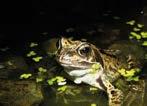
Birds at Spynes Mere

Spring is my favourite time of year here, with wintering birds lingering and summer migrants arriving. The wintering Gadwall, Shoveler, Wigeon and Teal normally depart by mid-April but there is always the hope that an incoming migrant Garganey will drop in. Breeding wildfowl include Canada and Greylag Geese, Mute Swan, Mallard, Coot, Moorhen and occasionally Water Rail. The Lapwing and Common Snipe tend to move off but if the water levels are low enough a passage of waders can be expected, including the odd Redshank, Greenshank, Dunlin, Little Ringed Plover, Ringed Plover, Oystercatcher, Black-tailed Godwit and Common, Green or even Wood Sandpipers –if you’re lucky.
The arrival of summer warblers makes a dawn visit worthwhile, with Common Whitethroat, Lesser Whitethroat, Garden Warbler, Blackcap, Chiffchaff, Cetti’s Warbler and Reed Warbler almost guaranteed, and the chance of
Willow and Sedge Warbler on passage. Last year a Nightingale put in a short visit. The scrub areas also hold breeding Bullfinch, Greenfinch and Yellowhammers. A mature oak tree to the south of Spyne’s Mere has a large hole that has had breeding Little Owl, Barn Owl, Kestrel and Stock Dove over the past few years (although never at the same time!).
One of the best treats is when the Sand Martins return in April, although they haven’t yet taken up their new artificial sandbank here. They breed a few hundred yards away at Mercer’s Quarry and feed regularly over the water often attracting hunting Hobbies which also feast on the large range of dragonflies that can be found across the site.
Which way to turn this springtime when Surrey’s diverse habitats offer so much?
The lake at Spynes Mere photo by Sand in your Eye © SWT
Common Frogs are relished by Grass Snakes and Herons
© Margaret Holland
Gordon Hay
20 SPRING RESERVES
Male Bullfinch © Bob Coyle
Graeme Hendry Wood
Mixed deciduous woodland reserve in an old sand quarry near Bletchingley.
This 10-hectare reserve is dominated by Ash and Sycamore, along with Pedunculate Oak, Sweet Chestnut, Silver Birch and Hazel. On the woodland floor there is Ivy, Wild Garlic, Enchanter’s Nightshade and Dog’s Mercury. Rarer plant species include Birds-Nest Orchid and Common Wintergreen.
In spring, the woods offer one of the finest displays of native Bluebells in the county. It’s also a wonderful time to see some old favourites –Nuthatches, Jays and Treecreepers (which have a call that sounds more like an insect than a bird).
The deep gullies that run east to west through the reserve provide shelter for a variety of interesting ferns, mosses and liverworts.
Chobham Common boasts a range of habitats. Sand Lizards like open sandy patches on our heathland sites.

WEST IS BEST
As conservation manager for our west Surrey reserves, Adam Bolton is a responsible for some of the best heathland in the UK:
“I’ve chosen three reserves that are grazed from April by our herd of Belted Galloway cattle to keep scrub in check.”
Chobham Common
The largest inland National Nature Reserve in south-east England.

Chobham Common is one of the finest remaining examples of lowland heath in England. It is home to the critically endangered Sand Lizard, which can be seen sunning itself from around April.
Fames Rough and Coneyboro Hill
Part of the Chipstead Downs Site of Special Scientific Interest (SSSI).
This 23-hectare reserve is a mix of woodland, scrub and grassland and a haven for many rare plant species, including spring wildflowers. It is also a splendid place to see butterflies, notably Green Hairstreak, Brown Argus and Dingy Skipper. The area is sheepgrazed by the Downland Project.
More than 100 different bird species have been recorded here, including the scarce Dartford Warbler, the Hobby and the Nightjar. Meanwhile, plant lovers can enjoy more than 300 species of wildflowers. Heather and gorses dominate the heathland, while the wetlands support insect-eating sundews and rare Marsh Gentians.
This is also one of the best British sites for spiders, and also bees and wasps. Some 29 species of butterfly live here, including the rare SilverStudded Blue, while 22 species of dragonfly hover and dart above the heathland pools.
Barossa

MOD training area near Camberley. Look out for Hobbies, Kestrels, Buzzards and Sparrowhawks. Hobbies are among the most agile and acrobatic birds of prey, capable of catching fast-flying birds such as Swallows and Swifts in mid-air. They have bred here for 20 consecutive years, but didn’t do so in 2022, so we are keeping fingers crossed for this year.
Elstead Common
One of a group of SWT-managed commons near Elstead.
Elstead adjoins the better-known Thursley Common National Nature Reserve and has much of the same wildlife interest. Look out for basking Adders, Woodlarks, Nightjars, Dartford Warblers, Tawny Owls, Woodpeckers and Cuckoos.
Like our other western sites, Elstead is a great place to look out for Tree Pipits, Redstarts and Chaffinches which, along with Greenfinches, have declined in our gardens but persist in pine and deciduous woodlands near the heathland.
 © Adobe / Stramyk Igor
Right: Sand Lizard – a rare species which benefits from our heathland management work © Jack Horton
Treecreeper, commonly sighted at Graeme Hendry Wood
© Bob Coyle
© Adobe / Stramyk Igor
Right: Sand Lizard – a rare species which benefits from our heathland management work © Jack Horton
Treecreeper, commonly sighted at Graeme Hendry Wood
© Bob Coyle
21 SPRING RESERVES
© Jack Horton
Who’s that warbler?
There are 14 UK species of these diminutive insectivores, although only Dartford Warbler is reliably resident year-round. In spring you might see the following species on the reserves we’ve covered here.
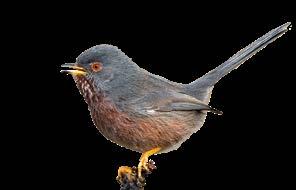
Blackcap
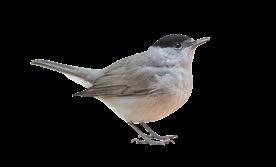

A fairly common visitor to gardens, the male has a distinctive sooty black ‘cap’, while the female’s headgear is brown.
Dartford Warbler
Rarer but highly distinctive, with a scarlet eye ring and maroon breast dusted with white. This heathland specialist is a notorious ‘skulker’ but is best spotted in Spring when it perches atop heathers and gorse to sing a scratchy song, which can also be delivered in the air during a short song-flight.
Get involved
Plump, with grey-brown upper parts and a slightly paler neck, this widespread but well-hidden species often inhabits woodland edges (rather than gardens) alongside its close relative the Blackcap.
Common Whitethroat


Distinguished by a long, white-bordered tail as well as the eponymous throat; males have a grey head and a more prominent white throat patch than females, which have a brownish head.
Warbler
A common specialist breeder in reedbeds, this is a plain warm-brown bird with a paler throat, underside and as a short stripe just in front of the eye. They are a favourite target species of the parasitic Cuckoo.
Whatever part of Surrey you belong to, we have plenty of volunteering opportunities. For details visit surreywildlifetrust.org/volunteer
Garden Warbler
Reed
© Adobe / Юрій Балагула
© Adobe / Daniele Occhiato
© Adobe / Daniele Occhiato
© Adobe / Nick Vorobey
22 SPRING RESERVES
© Adobe / Robin
SHOW OFF YOUR
SUPPORT
Our new online ethical clothing store is open!

You can now demonstrate your support for Surrey Wildlife Trust and back a more ethical approach to fashion shopping by using our new online clothing store.

It’s full of beautiful clothes for women, men, and children – all with original wildlife designs and subtle SWT branding. We’ve developed the shop in partnership with Teemill, a UK-based ethical clothing company that is helping lead the way towards a circular economy, while minimising its environmental footprint.
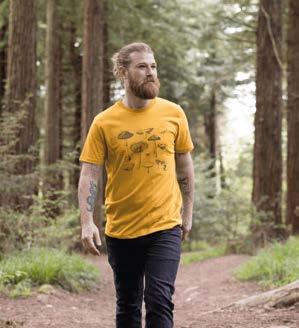
All our products are made from sustainably produced 100% organic cotton in a wind-powered factory. And when you’ve worn them out, they are designed to be sent back to the supplier and re-purposed, instead of contributing to landfill. Many designs, including jumpers, T-shirts and
hoodies, are made entirely of recycled materials. While this may sound like common sense, in fact it’s a radical move in an industry where 60% of conventional clothing is made from plastic and 99% is never recycled. Instead of manufacturing in bulk, which can lead to unnecessary waste, each item is made and despatched to order – a process that takes a few days at most.
SWT membership manager Jennifer Mason explains: “We want our members to be able to show their support in a practical way that delivers value for money and doesn’t harm the environment. By shopping with us you can boost a
Children's hoodie: Wild Thing

sustainable business, help increase SWT’s profile in the community and raise much-needed funds for our conservation work. We hope people of all ages will enjoy our bespoke designs, and we’d love to receive new ideas that reflect our work and the wildlife we treasure in Surrey.” ■
Check out the full range at: surreywildlifeshop.org
60% of conventional clothing is made from plastic
Women's long sleeve top: Dormouse
Men's Tshirt: Mushroom
SHOP 23
SPRING ONLINE
Skylark
My spring species
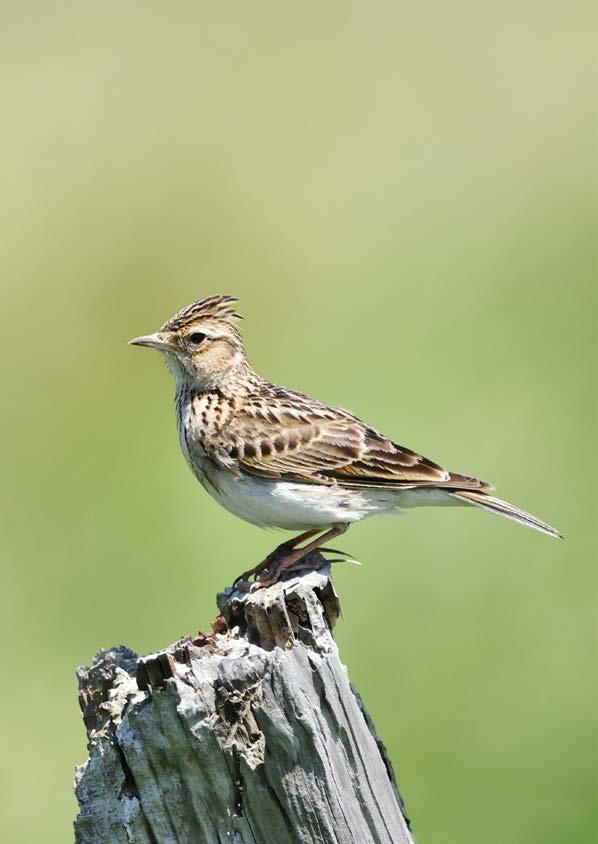
24 SPRING SPECIES FOCUS
© Adobe / dreamnikon
For me the frenzied rippling warble delivered from high overhead is a sign of warmer, lighter and brighter days. I grew up in Guildford and spent many childhood hours playing on the North Downs accompanied by this beautiful chorus. While its song is a prominent melody in grassland and farmland habitats, spotting the singer high in the sky can be tricky, often as a tiny black dot in a sea of blue.
As an adult I can now appreciate the challenges these small charismatic birds face: changes in land use and farming techniques (farmland is their favoured habitat); risks from predators including Foxes, Carrion Crows and domestic cats and dogs. Hen birds will sometimes fly up and away from the nest, singing to distract potential predators from the clutch of three or four eggs nestled in the grass. In ideal weather a pair can try for up to four broods in one season.
It would be wonderful to see Skylark numbers increase across Surrey, as they are a good indicator of sensitive farmland management. My three-year-old son noticed his first one this year, looking up and pointing to his ear… “listen”. I hope these beautiful birds can welcome in the Spring for many generations to come.

Conservation status
Listed in the UK as ‘Red’, as a high priority species for conservation by the Birds of Conservation Concern 4: the Red List for Birds (2021).
Statistics
Length: 18cm
Wingspan: 33cm
Weight: 35-42g
Average lifespan: two years
How to identify
Streaky brown with a small, erectable crest. Larger and with a longer tail than the otherwise similar Woodlark. Much larger than the similar Meadow Pipit, which has a thinner bill and no crest. A closer view will reveal long spurs on its heels, often dangled in flight.

Where to spot
SWT reserves that regularly host Skylarks include:
Priest Hill
Chobham Common
Pewley Meadows
The song of the Skylark can be heard throughout the year but really comes alive in March as the breeding season begins.
FACT FILE
Lucy Bryce, SWT nature-based solutions manager
25 SPRING SPECIES FOCUS
© Amy Lewis
Above: A Skylark in flight
© Stefan Johansson
TALKING TREES
Sue O’Regan, SWT adult learning officer
In fact, I’ve already planned my first chat – with the enormous Crowhurst Yew in St George’s churchyard, which is thought to be at least 1,500 years old. We could discuss the Roman legions who marched past on their way north or the various kings who hunted Wild Boar in the local woodland. I would ask how it felt to have a cannon ball embedded in it during the English Civil War, and whether it contributed to the parish council meetings once held inside its hollow trunk.
Internet of (living) things
While this might be a dream, in one sense it is a reality that trees have always communicated with each other, through the mycorrhizal fungal network that links tree roots. Trees use photosynthesis to produce food in the form of carbohydrates. They then share these with the fungi that live along their root line. In return the fungus finds and absorbs essential nutrients from the soil and shares them with the trees. Mycelia are the incredibly fine collective ‘threads’ formed by the vast underground part of fungal organisms, that wrap around or bore into tree roots. This huge subterranean network is often referred to as the ‘Wood Wide Web’.
Support system
There are numerous examples of trees sharing information. Suzanne Simard of the University of British Columbia identified a Douglas Fir that had been damaged by insects and appeared to send chemical warning signals to a Ponderosa Pine nearby. The pine then produced defence enzymes to protect against the intruders.
Professor Simard describes ‘mother’ trees as the biggest and oldest in the forest. They act as central hubs and have been found to transfer sugars, excess carbon and nitrogen to saplings via the ‘web’. Just like humans, these pillars of the community nurture their clan.
Sensory perception
In his book The Hidden Life of Trees, Peter Wohlleben describes how elms and pines under attack by leaf-eating caterpillars can detect the caterpillars’ saliva and release hormones that then attract predatory wasps. Similarly, certain trees emit large amounts of ethylene when their fruit is ripe. Related trees ‘smell’ this and ensure that their produce ripens at the same time, thus attracting animals to eat the fruit and disperse their seeds.
These are fascinating examples of co-evolved dependencies between widely varied organisms.
I was also amazed to learn that, though trees do not have nervous systems, they can feel a form of pain. When a tree is cut, it sends electrical signals in a similar way to wounded human tissue. There is also evidence that trees respond to pressure waves generated through sound and touch.
Embrace your local tree
I should also admit that I am an unashamed ‘tree hugger’. Wrapping my arms around a bold oak or sturdy beech makes me feel instantly calm and refreshed. This euphoria is partly caused by the dopamine, serotonin and oxytocin released into our hormonal system when we spend time in nature. However, trees also emit phytoncides to inhibit or prevent the growth of attacking organisms. These organic antibacterial and antifungal chemicals increase the number and activity of natural killer (NK) white blood cells and are widely used in alternative medicine and aromatherapy. The Japanese art of ‘shinrin-yoku’ or forest bathing, which is now prescribed by many NHS authorities, is based on the healing powers of these compounds.
26 SPRING TREES
If I had a superpower, it would be to converse with trees.
While I continue to fantasise about that lively conversation with the Crowhurst Yew, I also treasure the trees of my local woodland. I am in awe of their diverse resilience, communication abilities and healing properties. Their strength and stature will always encourage me to touch them and simply say ‘thank you’ – for which I am sure I have occasionally heard a whispered “you’re welcome” in reply. ■
Get to know the trees near you
Here are some of the best spots in Surrey for woodland with easy parking.
Staffhurst Wood, TN8 6GF –A beautiful deciduous woodland of Pedunculate Oak, Ash and Beech.
Sheepleas, KT24 6AP – Offers a mosaic of ancient and more recent woodland with veteran Beech trees.
Wallis Wood, RH5 5PL – A fine example of secluded, picturesque oak-dominated shade, with some Hornbeam and Alder.
Norbury Park, KT22 9BS – Famous for the Druids Grove of ancient Yews.
Thundry Meadows, GU8 6LE –Including a nationally renowned wet Alder woodland.
Come along to a forest bathing session at Nower Wood
Join one of our adult learning courses. As an SWT member you are entitled to a discounted rate:
The wonder of trees on 2 June
Tree identification on 29 June
For more details visit surreywildlifetrust.org
27 SPRING TREES
Driving nature’s recovery
Last autumn 70 employees from Kia UK joined forces with SWT to help restore valuable chalk grassland at Norbury Park by removing dozens of small trees, shrubs and islands of bramble.

Kia UK is a major supporter of our work. Its president and CEO, Paul Philpott, said: “It’s been great to get out of the office and work in the fresh air, strengthening relationships within our team and building new ones with our partners from SWT.”
Norbury’s 33 hectares of chalk grassland can sustain up to 40 species of flowering plants in one square metre, including rare Bee and Fly Orchids, Common
Bird’s-foot Trefoil, Rock-rose, Wild Strawberry, Agrimony, Salad Burnet and Creeping Cinquefoil. These in turn attract a wide variety of butterflies including Marbled Whites, Commas, skippers and Chalk-hill Blues. Birds and reptiles present include Linnets, Yellowhammers, Slow-worms and Adders.
Luke Parham, SWT reserve officer, said: “We work hard to increase biodiversity and bio-abundance in Surrey, but we can’t succeed without volunteers from all parts of the community. By helping us with scrub clearance, Kia UK is making a real difference to one of our most precious habitats.”
Premier Miton invests in a wilder Surrey
Premier Miton investment management service has committed to a three-year agreement to fund our Wilder Schools project and ongoing chalk grassland restoration. This reflects Premier Miton’s commitment to support nature. The funding agreement will sponsor a school to take part in SWT’s Wilder Schools project, which helps children learn about nature and take practical action within and outside their school grounds.
Two of our reserves, Hackhurst Down and Dawcombe, will also receive investment to maintain rare chalk grassland habitat on over 60 hectares. We hope to invite some of the Premier Miton team out to see the work that we’re doing during 2023.
A big thank you to all our business supporters
Gold partners
Balfour Beatty plc

Belron
Camberley Heath Golf Club
Chessington World of Adventures Resort
Jacobs
Kia UK
Mayer Brown
Molesey Veterinary Services
Premier Miton Investors
Priory Hospital (Woking)
Royal Wimbledon Golf Club
SES Water
STIHL
St George’s Hill Golf Club
Thakeham Homes
Toyota (GB)
UK Power Networks
West Hill Golf Club
Woking Golf Club
Silver partners
Affinity Water
Jenoptik
Mondi
Thames Water
Bronze partners
Clandon Wood Natural
Burial Reserve
Effingham Golf Club
NDC Garage Doors
Novex Solutions
rhw Solicitors
Sibelco (Europe)
Walton Heath Golf Club
Wienerberger
Small business partners
The Albury Co
Alpha Vets (Teddington and Claygate)
Aubergine Legal
Avery & Brown
Broadband UK
CS Virtual Assistant
Forays Homes
Landscaping Solutions
Lending Expert
Mortgageable
Novex Solutions
Wild Learning Business supporters and donors
Amazon Smile
Bell’s Whisky
Benevity
British Wildlife Centre
BUPA
Car Take Back
Chalford Property Co Ltd
Co-op
Cotswold Outdoor Clothing
Hitachi Capital
Network Rail
Project Five
Surrey County Council
Surrey Hills Photography
Tesco
University of Surrey
Vine House Farm
Waitrose
28
SPRING CORPORATE NEWS
Members of the Kia UK team get to work
SWT IN THE COMMUNITY...
Bees, beans and butterflies
As part of Nextdoor Nature, Surrey Wildlife Trust is working with St Clare’s Church in Guildford to bring the benefits of green spaces into people’s lives. Adrian Watts of St Clare’s tell us more about the community garden project he is leading.
Park Barn is a large former council estate to the north of Guildford. At its heart lies St Clare’s Church, home to a small congregation as well as the North Guildford Foodbank and now Park Barn Community Garden.
As with many estates built during this era there are many good sized gardens. Grass verges are still plentiful, and the church also benefits from a good sized ‘green’ adjacent to the local primary school. But these public spaces are largely green deserts with little in the way of biodiversity. This was equally true of the church green.
Inspiration from Todmorden
The inspiration for the community garden at Park Barn came from the ‘Incredible Edible’ project in Todmorden, Yorkshire, where people have come together to turn every former grass verge and every raised bed into a source of growing food for the community. Do look it up online.
Results come slowly…
Three years after the construction of our first raised beds from old wooden pallets, we have expanded to eight raised beds, planted our first fruit


trees and have built picnic benches. We are still small, and trying to secure more local involvement. But even with such a modest start, things are starting to change. With successful crops of potatoes, tomatoes and strawberries, we are seeing life return to the green – not only increased numbers of picnickers enjoying the local space, but also, slowly but surely, insect life. In fact one of our crop disasters was a great success for promoting biodiversity: our broad bean crop was completely decimated by black fly, but this in turn led to an influx of ladybirds. We have also started to see butterflies and bees around the green – wonderful to see!
Bringing people aboard
The project has not been without its frustrations – in particular in attracting local volunteers. But with the help of the wonderful Billie Pearce at Surrey Wildlife Trust we held a
community engagement morning this autumn. SWT provided the tools, the material and know how to build ‘bug hotels’ for the twenty plus locals who attended. From this session we established that we haven’t been the greatest communicators of what we’re doing – and that yes, it really is okay to come and help yourself to the produce! We have also hopefully got the support of two new volunteers –which is immensely encouraging.
In 2023 we will continue to organise the community – again with the support of SWT. We want to interact more with businesses and schools, something we can hopefully do with our new volunteers. I am confident that we have started something that will only grow; we are very grateful to have SWT alongside us for the journey.
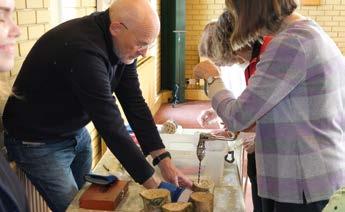
29 SPRING IN THE COMMUNITY
Adrian works with volunteers to create bug hotels
year of exciting marine sightings included a species completely new to science.

Pseudumbellula scotiae is a deep-sea coral that was discovered 240 miles off Scotland’s west coast, at depths of up to 2,000m in the Rockall Trough. There were also several species spotted in UK waters for the first time, with Cornwall Wildlife Trust volunteers discovering the first official record of a sea slug named Babakina anadoni Another sea slug found in Cornwall, Corambe testudinaria, was also new for the country, whilst Manx Wildlife Trust recorded the first ever swordfish off the Isle of Man.
Whales and dolphins delighted people from Scotland to Scilly, with sightings of pilot, fin, minke, and humpback whales showing how populations are recovering following bans on commercial whaling. Two new orca calves were spotted off Shetland in January, whilst volunteers recorded over 80 sightings of minke whales off the Yorkshire coast in a single morning in August. Monitoring by Yorkshire Wildlife Trust also suggests that bottlenose dolphins are now present off Yorkshire year-round.
In more distressing news, seabird colonies around the UK were devastated by our worst ever outbreak of avian flu,
From flukes to flu: our 2022 marine review
caused by intensive poultry farming. Tens of thousands of seabirds were killed by the disease, including terns, gulls, gannets, and skuas. Research shows that as much as 13% of the UK population of great skuas — 8% of the global population — have died.
Unfortunately, avian flu was just one of the issues putting pressure on our sensitive sea life. There were multiple reports of people disturbing marine animals, from jet skiers ploughing through colonies of seabirds to beachgoers distressing seals by getting too close. Pollution continued to be a major problem, with several oil spills including 500 barrels leaked from a cracked pipe off North Wales. A study of dead Manx shearwaters on Skomer island found the majority had eaten plastic, with adults feeding pieces to chicks. Scientists fear that 99% of seabirds may have plastics in their stomachs by 2050.
However, it wasn’t all doom and gloom for our seas, as Wildlife Trusts embarked on many projects to restore coastal habitats. These wild places often have a vital role to play in sequestering and storing carbon, as well as sheltering wildlife. Several Wildlife Trusts started projects to plant seagrass meadows, which can absorb and store carbon up to
35 times faster than tropical rainforests. Essex Wildlife Trust created a toolkit for restoring saltmarsh, another key habitat, to inspire and guide similar projects around the UK.
The UK will become the first nation to produce a complete map of its blue carbon stores. The Blue Carbon Mapping project — led by the Scottish Association for Marine Science (SAMS) in collaboration with The Wildlife Trusts, WWF and RSPB — has begun the task and will publish results this summer. Wildlife Trusts also helped empower young people and local communities to save our seas. Projects ranged from art students cleaning beaches with Durham Wildlife Trust, to Cheshire Wildlife Trust training teachers to deliver lessons on wildlife in the Dee Estuary.
Discover more about these and other stories in our full 2022 marine review: wildlifetrusts.org/marine-review-2022

UK NEWS UK UPDATE BREACHING
©
©
DOLPHIN
JOHN MACPHERSON; BABAKINA ANADONI SEA SLUG
ALLEN MURRAY
Bottlenose dolphins are a regular sight in UK seas
30
The colourful Babakina anadoni
The Great Big Nature survey launches

To help us understand how much nature matters to you, The Wildlife Trusts are launching The Great Big Nature Survey this spring. We want to hear your views on some of the most important issues affecting nature and wildlife, and your relationship with the natural world. How often do you get out into nature? Should people try to control nature to better protect it? How important are green spaces to you? What roles should people, business, and government have in looking after nature? Should local communities be at the centre of nature conservation on their doorstep?
Whatever your views on nature, however important (or not) it is to you, make your voice heard by taking The Great Big Nature survey today. With respondents from a variety of backgrounds and with many different
experiences in and views of nature and wild places, The Great Big Nature Survey will reveal what people in the UK and islands really think about nature and how we, as a society, should protect it. Results will also help The Wildlife Trusts to hold governments to account over environmental policies and priorities. After you’ve completed the survey, why not share it with your friends and family?
Take the survey at wildlifetrusts.org/ great-big-nature-survey or scan the QR code
UK HIGHLIGHTS
Discover how The Wildlife Trusts are helping wildlife across the UK
Hen party
The Northumberland Hen Harrier Protection Partnership, of which Northumberland Wildlife Trust is a member, announced a bumper breeding year for hen harriers in the county. Last year the partnership monitored nine nests, seven of which were successful — fledging a total of 26 chicks. This is eight more than in 2021 and brings the total since 2015 to 106 fledged birds. wtru.st/26-harriers
Give peat a chance
Derbyshire Wildlife Trust has been awarded a £100,000 Discovery Grant by Natural England to protect and restore the county’s peatlands. Peatland is a vital habitat, not just for wildlife but also for storing carbon. The grant will allow the Wildlife Trust to identify mechanisms to restore the region’s peatlands, so they can absorb and lock away carbon.
wtru.st/Derby-peat-grant
Mr Blean
Ragged robin has declined due to habitat loss

Plotted plants
The Wildlife Trusts are co-sponsoring production of the Botanical Society of Britain and Ireland (BSBI) Plant Atlas 2020, which is published this March. The Atlas is based on more than 30 million records collected by thousands of botanists between 2000 and 2019, providing
an unrivaled picture of the changing distribution and fortunes of plants in Britain and Ireland. This knowledge is likely to provide evidence to help us protect nature across the UK.
Find out more bsbi.org/atlas-2020
Kent Wildlife Trust has welcomed a male bison into the herd at West Blean and Thornden Wood. The bull’s arrival was delayed by post Brexit complications, but he has now joined the three females that were released in July, and the calf born in September. The bison have 50 hectares to roam as part of the Wilder Blean Project, a joint wilding initiative. wtru.st/bison-bull

UK NEWS UK UPDATE
Surrey Nature | Spring 2023 31
RAGGED ROBIN © KIERON HUSTON; BISON © EVAN BOWEN
ere at The Wildlife Trusts, we know how important it is that everyone has the opportunity to get out and enjoy nature. Across the UK, we look after around 2,300 nature reserves to help ensure that no matter where you live, you can enjoy a walk on the wild side. But nature can be sensitive. There are animals that are easily disturbed, plants at risk of trampling. Sometimes we have to impose restrictions to keep wild places wild.
Our communications recently have had a real focus on getting this message out to the public. We know our members are wildlife lovers that truly care about nature, so we wanted to highlight some of the issues that you’re helping us prevent by respecting nature reserves and the special species they protect.
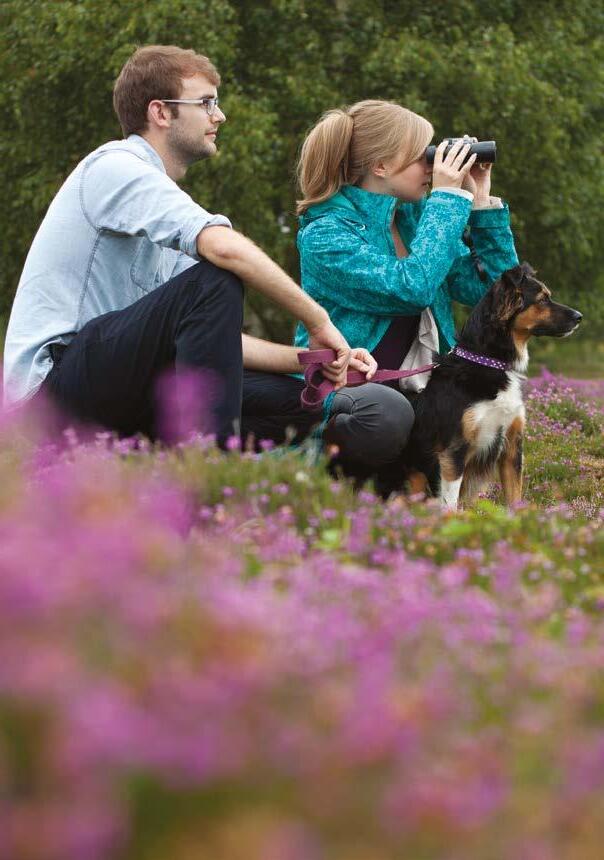
FAMILY WITH DOG © TOM MARSHALL
32
Paws for thought

Dogs are our most popular pet, with an estimated 13 million in the UK. They bring companionship and joy to their owners. They also lead people to be more active and spend more time in nature, which is great! But unfortunately for both us and wildlife, dogs and nature reserves aren’t always compatible. Even the most mild-mannered of our four-legged friends is still shaped like a predator, and that’s exactly how wild animals see them. A dog is a potential threat. Even if the dog doesn’t chase birds, squirrels, deer or other animals, its presence can cause them to stop feeding, become stressed, and even temporarily abandon a nest. Many birds nest or feed on the ground, where they’re vulnerable. When a dog is off lead and wanders away from the path, it has the potential to disturb even more wildlife. Man’s best friend can directly influence wild places too. Chemicals in flea treatments can leach into ponds, lakes, and rivers, harming wildlife. And dog poo isn’t just unpleasant to stand on, it also adds nutrients to the soil. Wee does the same. This can be disastrous for rare plants that are adapted to low nutrient levels. As the soil nutrients increase, these plants are crowded out by nutrient-loving plants like nettles. A recent study on Belgian nature reserves estimated that each year dogs add an average of 11kg of nitrogen and 5kg of phosphorous per hectare. Picking up the poo can reduce these numbers dramatically.
Slim pickings
Last autumn some Wildlife Trusts had issues with gangs of foragers sweeping through nature reserves, gathering bags of fungi. Wild foraging can be fun and useful (if you know what’s safe to eat), but it can lead to problems for wildlife and wild places if done too frequently. Picking mushrooms isn’t generally bad for the fungus itself, as they’re seasonal fruiting bodies, but lots of people roaming in search of them can lead to plants being trampled and ground compacted. There are plenty of animals that feast on fungi too, from flies to mice and deer — so it’s important that some are left for nature’s foragers.

The heat is on
The Wildlife Trusts’ Changing Nature report highlighted that climate change is increasing the risk of wildfires on our nature reserves. Hot, dry springs and summers turn heathlands, grasslands and forest floors to kindling. A single discarded cigarette or a barbecue is all it takes to ignite a blaze that can destroy acres of vital habitat for wildlife. Rare reptiles, protected plants, endangered insects, and ground-nesting birds can all be lost. But these fires don’t just harm wildlife, they also release huge amounts of carbon into the atmosphere and damage the ability of wild places to help fight the climate crisis. So thanks for packing a picnic instead and helping us spread the message.
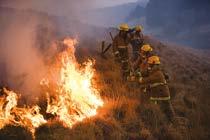
We hope this helps explain the need for restrictions in some of our wild places. Many Wildlife Trust nature reserves welcome dogs on leads, but some are so sensitive they need to be dog free entirely — so please check before you travel. Thank you for helping keep our wild places safe and setting a great example for other visitors..
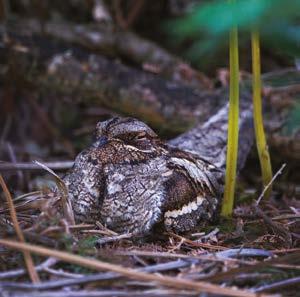
FIGHTING FIRES ©
©
TIPLING/2020VISION; BIRCH BOLETE ©
LEWIS;
JASON SMALLEY, NATUREPL; NIGHTJAR
DAVID
AMY
Surrey Nature | Spring 2023 33
Ground nesting birds like nightjars are especially vulnerable Fungi can be a feast for wildlife
BY HANNAH BAILEY, PHOTO © SARAH CUTTLE
Wildlife Gardening on a Budget
It doesn’t cost the earth to make a wildlife friendly garden. Indeed, the less money you spend the better for your pocket, wildlife and the planet.

Rather than buying plants grown in peat-based compost and plastic pots, grow them from seed in your own compost and an upcycled container. Take cuttings and dig up and divide plants to propagate more, and if you have too many why not share them with friends and neighbours who might return the favour? It’s a good idea to save seeds rather than buy fresh every spring, but don’t forget how good birds are at farming — if you’ve ever watched a goldfinch feeding on knapweed seed you’ll know that half of it ends up on the ground to grow into next year’s larder. Look out for berrying seedlings such as holly and hawthorn at the base of fences or other spots where birds like to perch, and — with the landowner’s permission — dig them up to grow for free in your garden.
It’s not just gardening that can be done cheaply. Want a log pile? Keep an eye out for neighbours doing tree work and ask if you can have a log or two. Want a new bird box? Find instructions online to make your own. Other ways to help wildlife require no money at all: let grass grow long around the edges, avoid cutting back plants and start a nice open compost pile at the end of the garden. Nature costs nothing, we just have to let her in.
Kate Bradbury is passionate about wildlifefriendly gardening and the author of Wildlife Gardening for Everyone and Everything in association with The Wildlife Trusts. Get more tips for helping nature at home from wildlifetrusts.org/gardening

ILLUSTRATIONS
34
Grow annuals from seed

Pollinator-friendly favourites like sunflowers and cosmos are easy — simply sow in pots of peat-free compost and plant out in early summer.
Make new plants from old Dig up herbaceous plants like nepeta and cranesbills and use an old bread knife to slice the rootball in two, with intact stems. Replant and water well.

Take softwood cuttings

Cut 10cm shoots from shrubs like lavender, remove lower leaves and push into pots of moist, gritty compost. Cover with a plastic bag sealed with an elastic band and keep on a bright windowsill for eight weeks.

Make a log pile Neighbours pruning or cutting down a tree? Ask for some logs! Piled up in a corner or beneath a bench they provide an easy, inexpensive habitat.
Be less tidy
Let an area of grass grow long, allow leaves to pile up in borders, deadhead and cut back less.

Make your own habitat boxes
From bird and bat boxes to hedgehog feeding stations and even “toad abodes”, there are plenty of instructions online on how to make your own bespoke wildlife homes.

Grow your own bird food


Home-grown bird food is free: avoid cutting back seedbearing plants like lavender, knapweed, grasses, sunflower and Verbena bonariensis, and watch the birds flock to feed from them.
Enjoy free gifts from birds
Birds make great farmers. Keep an eye out for holly and hawthorn seedlings, often found at the base of fences or other ‘perches’. With the landowners permission, dig them up and plant in your garden!
GARDENING FOR WILDLIFE Surrey Nature | Spring 2023 35

Andrew Parkinson/2020VISION Leaving a gift in your will can help us to protect nature and inspire future generations to love it too surreywildlifetrust.org/legacies Your love of You can also call us on 01483 795445 or email fundraising@surreywt.org.uk live on nature can Surrey Wildlife Trust






















 Mike Waite, SWT Director of research and monitoring
Mike Waite, SWT Director of research and monitoring



 Schofield
Schofield











 © Adobe / Fabrizio Moglia
© Adobe / Fabrizio Moglia








 © Adobe / Stramyk Igor
Right: Sand Lizard – a rare species which benefits from our heathland management work © Jack Horton
Treecreeper, commonly sighted at Graeme Hendry Wood
© Bob Coyle
© Adobe / Stramyk Igor
Right: Sand Lizard – a rare species which benefits from our heathland management work © Jack Horton
Treecreeper, commonly sighted at Graeme Hendry Wood
© Bob Coyle




































